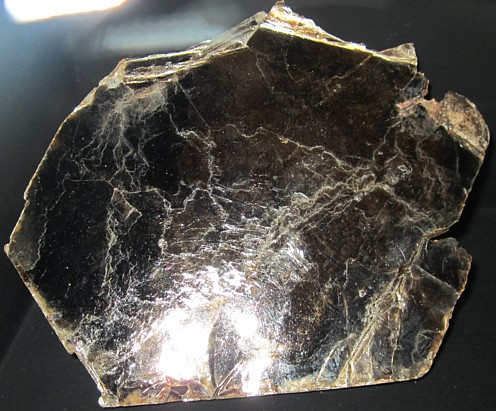|
.
Biotite Mineral Facts:
Chemical Formula:
K(Mg,Fe)3(AlSi3O10)(F,OH)2
A
magnesium-iron mica. The micas
form a series of complex silicates of aluminum with potassium and
hydrogen, also often magnesium, ferrous iron, and in some varieties,
sodium, lithium, ferric iron. More rarely
manganese,
chromium, barium, fluorine and titanium are present in small amounts.
Colors:
yellow,
green and brown
to black.
Color
usually dark green
and brown to black. More rarely lighter yellow. Thin sheets usually have
a smoky color differing from
the almost
colorless muscovite.
Pleochroism is strong
in sections
perpendicular to the perfect cleavage.
Hardness:
2.5 to 3
Density:
2.95
to 3.0
Cleavage:
Perfect basal cleavage
that is very easily developed as it is in all the Mica minerals.
The cleavage folia are flexible
and
elastic.
Crystallography: Monoclinic
In tabular or
short prismatic crystals with prominent basal planes. Crystals rare, and
frequently take a pseudorhombohedral form. The structure is usually in
irregular foliated masses; often in disseminated
scales or
in scaly aggregates.
Luster:.
Vitreous to pearly
luster. It is translucent to opaque.
Optics:
(Refractive Index):
=
a= 1.562, b = 1.606; y = 1.606
|

Biotite Mica |
|
Composition,
Structure and Associated Minerals:
Biotite is an important and
widely distributed rock-making mineral, but not as common as muscovite. It
occurs in igneous rocks, especially those in which feldspar is prominent,
such as granite and syenite. Found also in many felsite lavas and
porphyries. Less common in the ferromagnesium rocks. Is also present in some
metamorphosed rocks, as gneiss and schist. Occurs in fine crystals
in the lavas
of Vesuvius.
The biotites are among the
common constituents of igneous and metamorphic rocks and pegmatite dikes.
They also are common alteration products of certain silicates, such as
hornblende and augite. They are present in sedimentary rocks principally as
the
products of weathering. The commoner
alteration products of weathering upon biotite are a hydrated biotite,
chlorite,
epidote, sillimanite and
magnetite, if the mica is ferriferous. At
the same time there is often a separation of
quartz. Phlogopite alters to a
hydrophlogopite and to penninite, and talc.
Identification
and Diagnostics
Before the
blowpipe the dark, ferruginous varieties fuse easily to a black glass; the
lighter colored varieties with greater difficulty to a yellow glass. Their
powder reactions are strongly alkaline. The minerals are not attacked by HCl
but are decomposed by strong H2SO4. It is decomposed
by boiling concentrated sulfuric acid, giving a milky solution.
In the closed tube
all varieties give a little water.
Characterized by its micaceous structure,
easy cleavage and dark color.
The biotites are distinguished from all other
minerals except the other micas by perfect cleavage and from other micas by
their color, solubility
in strong
sulfuric acid and pleochroism. |
|
|
Occurrence,
Localities and Origins:
The occurance
of the different varieties of mineral are as follows:
Anomite is rare. It occurs at Greenwood Furnace,
Orange Co., N. Y., and at Lake Baikal, in Siberia. Meroxene is the name
given to the common biotite of the 2d order. It occurs in particularly fine
crystals in the limestone blocks included in the lava of Mte. Somma, Naples,
Italy; at various points in Switzerland, Austria and Hungary; and at many
other points abroad and in this country. Lepidomelane is a black meroxene
characterized by the presence in it of large quantities of ferric iron. It
is essentially a magnesium-free biotite. It occurs in igneous rocks,
especially those rich in alkalies. Two of its best known occurrences in the
United States are in the nepheline syenite at Litchfield, Maine, and in a
pegmatite in the northern part of Baltimore, Md. Phlogopite, or amber mica,
is the nearly pure magnesium biotite which by most mineralogists is regarded
as a distinct mineral, partly because in nearly all cases it contains
fluorine. Its color is yellowish brown, brownish red, brownish yellow, green
or white. Its luster is often pearly, and it frequently exhibits asterism in
consequence of the presence of inclusions of acicular crystals of rutile or
tourmaline arranged along the rays of the pressure figure. Its axial angle
is small, increasing with increase of iron. Phlogopite is especially
characteristic of metamorphosed limestones. It occurs abundantly in the
metamorphosed limestones around Easton, Pa.; at Edwards, St. Lawrence Co.,
N. Y., and at South Burgess, Ontario, Canada. It is also found as a
pyrogenetic mineral in certain basic igneous rocks
Return to the
Mineral Collectors Information Page
|


